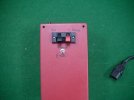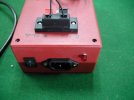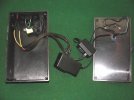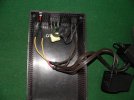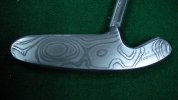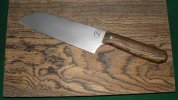- Joined
- Feb 16, 2010
- Messages
- 3,668
Not quite as simple as my other projects, but still easy. Quite a bit less to go wrong with it, also.
Let's start with a parts list.
1. Project box FREE
2. DPDT switch, preferably panel mount $2
3. 6' extension cord $1
4. alligator clips $2
5. 12VAC wall transformer $3
6. 12VDC wall transformer $3
Optional items
7. 2 wire speaker jacks, RCA jack, or something to plug the leads into $1
8. 120v pilot light $2
9. Power switch FREE
10. computer power supply plugin FREE
First, find a box big enough to hold two plug in all transformers. I found a bunch on eBay for $5, they measured 4" x 2½" x 7½". Plastic is probably a good idea. Other eBay purchases will probably be the transformers and DPDT switch. Transformers sell for about $3 each on ebay, a 6 pack of switches cost $5.
I first used a dead power supply from a computer. Computer repair shops recycle dozens of them each year and would probably give you one for free. It's a nice metal box, has a power switch already installed and plugin already installed, and easily first both transformers. If you use one, just remove everything from inside it, including the fans. I've switched to a plastic project box just because I use power supplies for everything and this looks nicer.
Begin by mounting your plugin or extension cord to the box. Wire up the transformers to the cord/plugin. If using the power supply with power switch, make sure to keep it intact. It should be a double pole on/off switch and will completely shut off the power to the transformers. Attach the power light, if used, to the transformer side of the switch.
Cut the transformer leads down to about 8". You don't need the rest of the cable inside the box. Attach the transformer outputs to the DPDT switch and the output of the switch to speaker jack. Mount the speaker jack to the box and use some double stick foam tape to secure the transformers inside the box.
The switch should have three rows of two pins. The middle two pins are the output of the switch. Attach the alligator clips to a flexible piece of wire. I used the leads from the transformer and made a couple sets of clip leads.
So, to refine the process: Box, extension cord, transformers, clips. Wire the transformers to the switch and attach to speaker jacks. Attach leads to jacks, clip the red clip to the blade and use the black clip to hold a Q-Tip. I use a few shakes of table salt and about 1 oz. of water for electrolyte. Make sure to get the black clip close to the end of the Q-Tip.
Here's a few pictures of mine.





Extra wiring on outlet is directly from power supply. I'm pretty certain they are just filters to keep the signal clean. You don't need them if you don't have them.

I hope you've enjoyed today's episode of Fun with ELECTRICITY!
Let's start with a parts list.
1. Project box FREE
2. DPDT switch, preferably panel mount $2
3. 6' extension cord $1
4. alligator clips $2
5. 12VAC wall transformer $3
6. 12VDC wall transformer $3
Optional items
7. 2 wire speaker jacks, RCA jack, or something to plug the leads into $1
8. 120v pilot light $2
9. Power switch FREE
10. computer power supply plugin FREE
First, find a box big enough to hold two plug in all transformers. I found a bunch on eBay for $5, they measured 4" x 2½" x 7½". Plastic is probably a good idea. Other eBay purchases will probably be the transformers and DPDT switch. Transformers sell for about $3 each on ebay, a 6 pack of switches cost $5.
I first used a dead power supply from a computer. Computer repair shops recycle dozens of them each year and would probably give you one for free. It's a nice metal box, has a power switch already installed and plugin already installed, and easily first both transformers. If you use one, just remove everything from inside it, including the fans. I've switched to a plastic project box just because I use power supplies for everything and this looks nicer.
Begin by mounting your plugin or extension cord to the box. Wire up the transformers to the cord/plugin. If using the power supply with power switch, make sure to keep it intact. It should be a double pole on/off switch and will completely shut off the power to the transformers. Attach the power light, if used, to the transformer side of the switch.
Cut the transformer leads down to about 8". You don't need the rest of the cable inside the box. Attach the transformer outputs to the DPDT switch and the output of the switch to speaker jack. Mount the speaker jack to the box and use some double stick foam tape to secure the transformers inside the box.
The switch should have three rows of two pins. The middle two pins are the output of the switch. Attach the alligator clips to a flexible piece of wire. I used the leads from the transformer and made a couple sets of clip leads.
So, to refine the process: Box, extension cord, transformers, clips. Wire the transformers to the switch and attach to speaker jacks. Attach leads to jacks, clip the red clip to the blade and use the black clip to hold a Q-Tip. I use a few shakes of table salt and about 1 oz. of water for electrolyte. Make sure to get the black clip close to the end of the Q-Tip.
Here's a few pictures of mine.





Extra wiring on outlet is directly from power supply. I'm pretty certain they are just filters to keep the signal clean. You don't need them if you don't have them.

I hope you've enjoyed today's episode of Fun with ELECTRICITY!
Attachments
Last edited:

